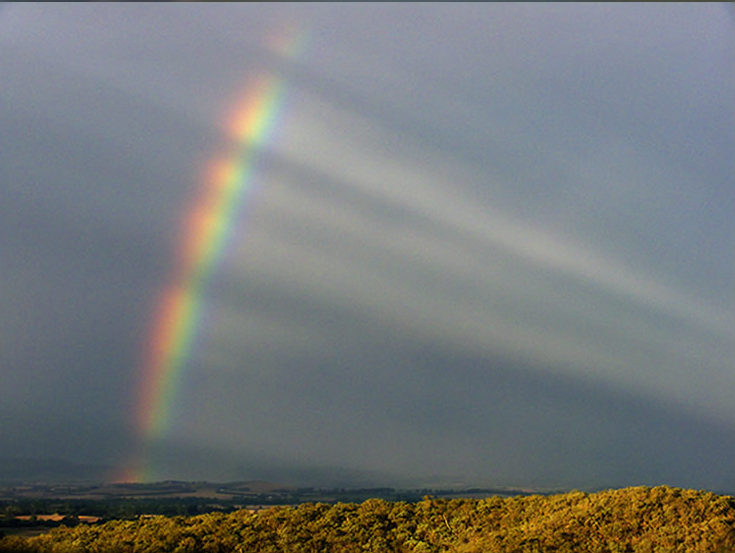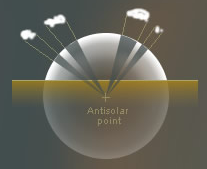Wheels & Spokes
Wheels & Spokes: A Closer Look at Rainbow Disks
Rainbows are one of nature's most captivating phenomena, captivating both scientists and the general public alike. But did you know that rainbows are not just simple arcs of color in the sky? They are actually disks of light, with their edges appearing brighter than the rest. In this article, we will delve deeper into the fascinating world of rainbow disks and explore the intricate details of their formation.
The Overlapping Disks of Color
When we observe a rainbow, we see a beautiful display of colors arching across the sky. However, if we were to zoom in and examine it closely, we would discover that rainbows are composed of overlapping disks of different sizes. Each disk represents a specific color, and when these disks combine, they create the illusion of a curved rainbow.
The Antisolar Point and Shadow Convergence
Have you ever wondered where the center of a rainbow is located? It turns out that the disks of color are centered on a point directly opposite the sun, known as the antisolar point. This is where the magic happens. When sunlight passes through raindrops and refracts, it creates a circular pattern of light that converges at the antisolar point, forming the disks we perceive as a rainbow.
Not only is the antisolar point significant for rainbow formation, but it also plays a role in shadow convergence. Shadows cast by objects on the ground appear to converge towards the antisolar point due to perspective. So, next time you find yourself standing in the presence of a rainbow, take a moment to notice how shadows align towards this point as well.
Unveiling the Mystery of Rainbow Spokes
One intriguing feature of rainbows is the presence of "spokes," dark areas within the disks of color. These spokes are not random occurrences but have a distinct explanation. They occur when raindrops are shadowed by clouds, preventing them from reflecting and refracting light. As a result, these shadowed raindrops cannot contribute to the overall brightness of the disk, creating the appearance of spokes within the rainbow.
It's important to note that while spokes are related to anticrepuscular rays, they are not the same phenomenon. Anticrepuscular rays are beams of sunlight that appear to converge towards the antisolar point, similar to shadows. Spokes, on the other hand, are specifically associated with the shadowing of raindrops by clouds.
Exploring the Intricacies of Rainbow Disks
Now that we have unraveled some of the mysteries surrounding rainbow disks, let's dive into their intricate details. Here are a few additional points to consider:
- The size of each disk within a rainbow depends on the size of the raindrops responsible for refracting light.
- The overlapping disks of color create the distinct edges that give rainbows their bow-like appearance.
- The intensity of each color within a rainbow can vary based on atmospheric conditions and the angle of observation.
- Under certain circumstances, double rainbows may form, with a fainter secondary rainbow appearing outside the primary one.
- The colors we see in a rainbow, from red to violet, are a result of the varying wavelengths of light being refracted and dispersed by raindrops.
- Rainbows can also occur in non-rain environments, such as waterfalls or sprinklers, where water droplets act as prisms.
In conclusion, rainbows are not just simple arcs of color but intricate disks of light that captivate our imagination. By understanding the overlapping disks, the significance of the antisolar point, and the formation of spokes, we gain a deeper appreciation for the beauty and complexity of these natural wonders. So, the next time you find yourself gazing at a rainbow, take a moment to ponder its inner workings and let its enchantment fill your soul.

Rainbow Spokes seen by Ern Mainka (photography site) in Australia 25th March '08. Image ©Ern Mainka, shown with permission.
Rainbows are actually disks of light brighter at their edges. The disks of each colour overlap but are of different sizes and hence we see their coloured edges - they are the bow.
The disks are centred on the antisolar point directly oppositie the sun and this is also where shadows converge by perspective.
The dark parts of the 'spokes' are where raindrops are shadowed by clouds and are therefore unable to glint light and contribute to the light of the disk. The spokes are related to - but not the same as - anticrepuscular rays

Note: this article has been automatically converted from the old site and may not appear as intended. You can find the original article here.
Reference Atmospheric Optics
If you use any of the definitions, information, or data presented on Atmospheric Optics, please copy the link or reference below to properly credit us as the reference source. Thank you!
-
<a href="https://atoptics.co.uk/blog/wheels-spokes/">Wheels & Spokes</a>
-
"Wheels & Spokes". Atmospheric Optics. Accessed on November 26, 2024. https://atoptics.co.uk/blog/wheels-spokes/.
-
"Wheels & Spokes". Atmospheric Optics, https://atoptics.co.uk/blog/wheels-spokes/. Accessed 26 November, 2024
-
Wheels & Spokes. Atmospheric Optics. Retrieved from https://atoptics.co.uk/blog/wheels-spokes/.